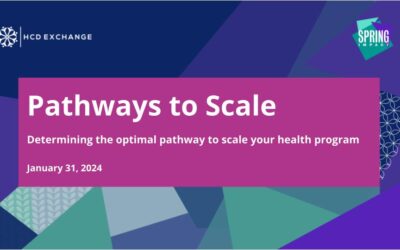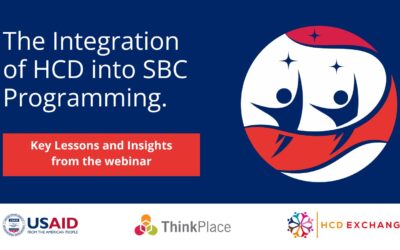On 14th of April, our community convened for a panel discussion on the role and importance of quality in human-centred design (HCD) and adolescent sexual and reproductive health (ASRH) programming. As we work to build the field of HCD + ASRH as a more mainstream way of running this kind of programming, we want to ensure that quality remains central to these programmes, and there are universal standards for evaluating quality. This helps to ensure that all stakeholders are held accountable to the same standard and we can avoid the use of tokenistic human-centred design approaches. It also ensures that we are thoughtful and intentional about how and why we use these approaches throughout programme design, implementation, and evaluation stages.
Launching a Quality & Standards working group
Quality & standards are a core pillar to the learning work of the HCDExchange – identified as an area that must be built out alongside the growth of this field. To lead this work, the HCDExchange has partnered with YLabs, to launch and chair a working group on Quality & Standards in HCD + ASRH. Nicole Ippoliti, Director of Global Programmes for YLabs and co-lead of the working group announced the launch of this working group during the Community Call. Their key deliverable will be a Quality Standards framework for the use of HCD in ASRH work. This will act as a guide for programme implementers, designers, and funders to ensure that the use of HCD approaches are ethical and effective within our ASRH work. This will be collaboratively co-created alongside the community before launching community- and sector-wide later this year. Learn more about the Quality and Standards Working Group.
Panelists from the HCDExchange Community
The panel for this discussion was made up of geographically diverse members of the HCDExchange Community of Practice, representing different stakeholder groups within the HCD + ASRH field. This included emerging and experienced designers, donors, programme implementers, and researchers. We have captured key highlights from the discussion in the section below, but encourage those who weren’t able to attend to listen to the full recording of the call to hear their many insights on this topic.
- Mireille Umutoni Sekamana – Designer, YLabs (Rwanda)
- Michael Kamiru – Programme Analyst, CIFF Africa (Kenya)
- Aïssatou Dione – UX Researcher, YUX (Senegal)
- Madiha Latif – Program Manager, Beyond Bias, Pathfinder International (Pakistan)
- Dr. Tabinda Sarosh – Country Director, Pathfinder International (Pakistan)
KEY HIGHLIGHTS
Quality means listening to your beneficiaries, and grounding in empathy
What came through strongly from all of our speakers is that using human-centred design approaches organically leads to quality within the programme design and implementation stages of ASRH projects, because it focuses on the value of co-designing and co-creating alongside the people you are working to serve. Dr. Tabinda summed this up nicely – the ethos of HCD is empathy – this co-designing and shared ownership of the solution drives quality in the design and implementation stages. Madiha also highlighted the importance of representation to quality; including those you are trying to benefit is crucial to the process. Michael built on this, sharing on CIFF’s approach to having very detailed conversations with their beneficiaries – using HCD approaches allows us to really listen to them, and gives a higher chance that the programme will be successful. Lastly, quality is also protecting the people who you are working with, and abiding by ethical standards when it comes to working with youth and adolescents – this must be at the core of this work.
Quality uses evidence-based approaches and relies on robust data-use
Aissatou spoke on the importance of transmitting the data we receive throughout the design process, and the need to use that data to build out solutions. Dr. Tabinda and Madiha mentioned that other, complimentary research can also be used to fully understand the context of your beneficiaries, the policies that influence them and on-the-ground realities – for example market segmentation and expert interviews. Part of how HCD can be used to support this is by designing and building feedback loops into the process and to the solution/programme itself. This is how Michael explained how his projects have had consistent communication with their beneficiaries. Nicole summarized this point succinctly – it’s the ability to get constant and iterative feedback from the people with who and for whom they are designing. Being open to listening to that feedback, and using it to iterate. Lastly, using data also helps us as designers and practitioners to avoid our own biases that may affect our work.
Quality means useability
Mireille shared a really applicable example of iterating on a product that they thought was complete. They thought they had all of the functionalities that were needed, but girls wanted it to be simpler. Quality doesn’t just mean building the best product you can imagine, it means aligning that product to the needs and realities of your users. The idea of useability also applies to the process by which we engage with young people – for example, Aissatou mentioned that she and her team needed to spend time listening to the girls they designed with, and learning the language and vocabulary that the girls use to describe sexual and reproductive health topics and ideas. This helped them to meet the girls where they were and open up safe spaces for dialogue.
It also means that we must talk about the things that our beneficiaries want to talk about. Dr. Tabinda rightly pointed out that SRH is not the only thing that is important to them. Family concerns, livelihoods, dreams about the future; there are different pressing issues to young people, so we must address those other aspects even if we are focusing on ASRH at the core of our programme or solution.



